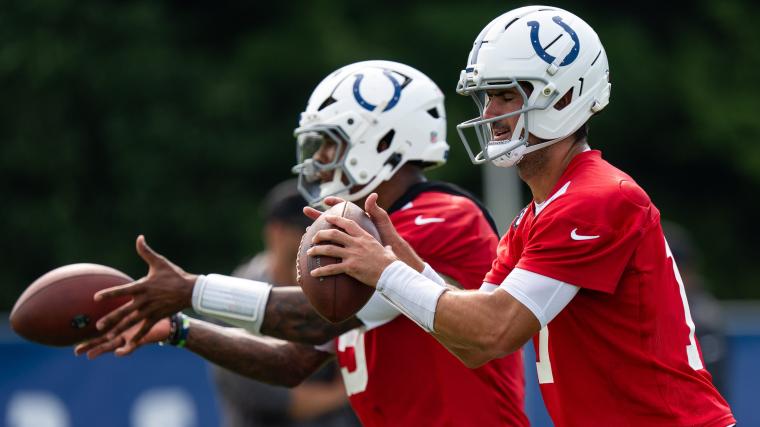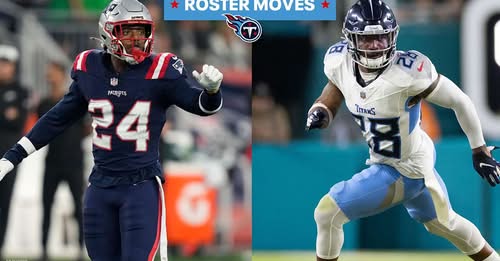Quarterback Controversy in Indianapolis? Anthony Richardson and Daniel Jones Both Listed as QB1 on Colts’ Unofficial Depth Chart Heading Into Preseason
In what has become one of the most surprising storylines of the 2025 NFL preseason, the Indianapolis Colts released their unofficial depth chart earlier this week with a stunning twist—both Anthony Richardson and newly acquired Daniel Jones are listed as co-starters at the quarterback position. This unexpected development has set the NFL world ablaze with speculation and intrigue, as fans, analysts, and fantasy football managers try to decode what this decision signals for the direction of the Colts’ offense, coaching philosophy, and long-term vision. For a franchise that appeared to have found its quarterback of the future in Richardson, who flashed moments of brilliance during his limited rookie season before suffering a shoulder injury, the move to bring in Jones during the offseason already raised questions. But placing him on equal footing with Richardson heading into preseason games escalates those questions into full-blown controversy.
To understand how the Colts arrived at this quarterback conundrum, it’s important to examine the context surrounding each player. Anthony Richardson was selected fourth overall in the 2023 NFL Draft out of Florida, with the Colts betting heavily on his rare athleticism, arm strength, and long-term upside. Despite being raw in terms of mechanics and experience, Richardson displayed flashes of his high ceiling during his rookie campaign, rushing for touchdowns and making explosive plays downfield before his season was cut short by injury. Since then, he has reportedly dedicated himself to mastering Shane Steichen’s playbook, improving his timing, and refining his accuracy—all signs pointing to his reclaiming the starting role without much resistance. Enter Daniel Jones, the former New York Giants signal caller, who was signed by the Colts in the spring following his release from New York after an injury-marred and inconsistent tenure. Though Jones has faced criticism for his erratic play and turnover issues, his experience, mobility, and flashes of strong decision-making under pressure offer qualities that any coaching staff could find appealing in a backup or bridge starter.
Still, few expected Jones to be listed alongside Richardson as a co-QB1 in the first depth chart of training camp. While unofficial, these early charts often reflect the internal temperature of a coaching staff evaluating performance, leadership, and command of the offense. So when the Colts released their chart and listed both quarterbacks in the top slot, the message was clear: there is no guaranteed starter in Indianapolis right now. Whether this is a motivational tactic by Steichen to push Richardson, a reflection of concerns over his readiness, or a genuine belief that Jones could offer a viable alternative remains unclear. What is certain, however, is that the situation adds pressure, competition, and drama to a franchise desperate for stability under center. After cycling through a carousel of quarterbacks since Andrew Luck’s sudden retirement, the Colts finally invested in a young, dynamic talent in Richardson—only to now find themselves weighing veteran reliability against long-term development.
The public reaction to the dual-QB1 designation has been swift and polarized. Supporters of Richardson argue that this move undermines the confidence of a young quarterback who needs full backing from the organization to grow into a franchise leader. They see this as a misstep that could rattle the development process and potentially stunt his growth by dividing reps, splitting locker room loyalty, and confusing the offensive identity. Conversely, supporters of competition welcome the move, pointing out that no job in the NFL should be handed out unconditionally. If Daniel Jones outperforms Richardson in preseason games or displays a better command of the offense in high-pressure situations, then he deserves a shot to start. While that may be a reasonable stance in a vacuum, the real concern lies in how a quarterback rotation or battle could impact team chemistry, offensive rhythm, and locker room clarity.
The preseason games will now take on an added layer of importance for the Colts. Every snap, throw, and drive from Richardson and Jones will be scrutinized for signs of who is truly winning the job. Coaches will evaluate accuracy, decision-making, command in the huddle, and performance against live defenses. While Richardson offers a higher ceiling with his dual-threat capabilities and game-changing athleticism, Jones provides a safer floor and more experience in managing NFL-level pressure. However, experience doesn’t always equate to effectiveness. Jones struggled last year in New York behind a porous offensive line and was often criticized for his inability to elevate the play of those around him. His inconsistency in reading defenses and avoiding costly turnovers has followed him throughout his career, leading many to question whether he’s truly capable of leading a playoff-caliber team.
On the other hand, Richardson’s upside is undeniable. His combination of size, speed, and arm talent makes him one of the most physically gifted quarterbacks in the league. What he lacks in experience, he makes up for in raw ability, and the hope inside the Colts organization has always been that with proper development, he could become the next elite quarterback in the NFL. Last season, before his injury, he showcased that potential with several highlight-reel plays, including rushing touchdowns and deep completions under pressure. But questions remain about his ability to process complex defenses, avoid injury, and sustain production over a full 17-game season. By listing both quarterbacks as co-starters, the Colts may be signaling that while Richardson remains the future, they’re not entirely sure he’s the present.
The move also raises questions about Shane Steichen’s leadership and offensive vision. Is he truly open to a quarterback battle, or is this more about optics and maintaining internal accountability? Steichen, who came from Philadelphia where he helped develop Jalen Hurts into an MVP candidate, was expected to follow a similar developmental blueprint with Richardson. That would typically involve unwavering support, tailored play-calling, and building the offense around his quarterback’s strengths. Instead, the dual-QB1 designation opens the door to potential instability and distractions. In a league where continuity at quarterback often translates into success, this type of indecision—whether real or performative—can be costly.
It also begs the question: what does this mean for the rest of the roster? Wide receivers, tight ends, and offensive linemen thrive on familiarity with their quarterback. Splitting reps between Richardson and Jones could delay chemistry, timing, and overall cohesion. It also complicates preparation for opponents and limits the ability to install a fully specialized game plan. If the quarterback competition stretches into the regular season, it could result in an identity crisis for a Colts offense already trying to establish itself in a crowded AFC South.
From a fantasy football perspective, this development throws significant uncertainty into the mix. Richardson was being drafted as a mid-to-late QB1 in most formats, largely due to his rushing upside and breakout potential. Jones, meanwhile, was being left undrafted in many leagues or taken as a late-round flyer in superflex formats. Now, with the depth chart reflecting a true competition, fantasy managers are left guessing. If Richardson loses meaningful snaps or fails to secure the Week 1 job, his fantasy ceiling takes a massive hit. Conversely, if Jones emerges as the starter, he could become a high-value pickup—particularly in formats that reward rushing production from quarterbacks. But the ambiguity also means managers must proceed with caution, as a split workload or mid-game substitutions could render both quarterbacks unplayable in standard leagues.
As the Colts prepare for their first preseason game, all eyes will be on the quarterback rotation. Reporters will analyze snap counts, drive results, and sideline body language for any clues as to who holds the edge. Teammates will be asked to weigh in, coaches will face endless questions, and fans will dissect every pass. It’s a situation that demands clarity, yet the Colts seem intent on embracing ambiguity—at least for now. Whether this is a genuine competition or simply a calculated message to keep both players sharp, the ripple effects will be felt across the organization.
Ultimately, the Colts’ decision to list both Anthony Richardson and Daniel Jones as co-starters on the unofficial depth chart may be one of the boldest, most controversial moves of the 2025 preseason. It reflects a franchise at a crossroads—caught between investing in long-term potential and seeking immediate results. Whether it’s a stroke of motivational genius or a sign of deeper uncertainty remains to be seen. But one thing is clear: the quarterback situation in Indianapolis is far from settled, and the spotlight will remain fixed on Lucas Oil Stadium until a clear starter emerges and leads the Colts into a new era.



